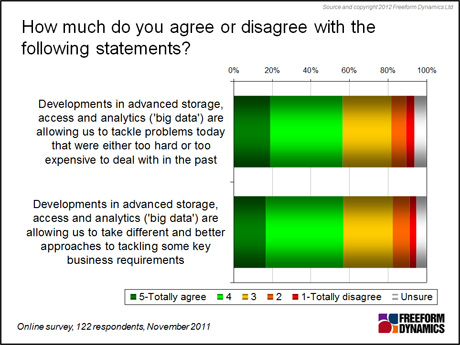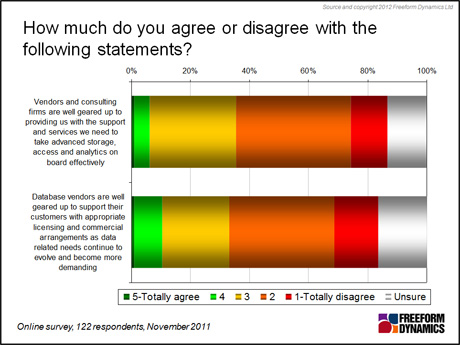By Tony Lock
CIOs have been subjected to the combined efforts of a significant proportion of the IT vendor community shouting about ‘Big Data’ for over two years. The wave of marketing and associated evangelism shows little sign of falling away. But given that few organisations have yet to implement Big Data solutions in anything but evaluation mode or very closely confined projects, should the subject even be on the table for real world usage in the next budget cycle or two?
The reality is that while Big Data attracts all the headlines, there is far lower hanging fruit for most CIOs to focus on. Chief amongst these is the fact that in a survey carried out by Freeform Dynamics only a half of organisations report they get close to fully exploiting the data they hold.
There are several reasons for this, not the least of which is that in the majority of enterprises data is fragmented across many separate platforms making it very difficult for users to locate the information they require when they need it. This often leads to important decisions being delayed or made with incomplete data, frequently both, never mind the unwritten cost in terms of wasted staff time and frustration. Addressing the data fragmentation issue holds many potential benefits for CIOs as they seek ways to improve daily analytics to support decision making by business users.

Figure 1
As Figure 1 illustrates, there is an expectation that advances in storage technologies and business analytics will allow organisations to better tackle some key business requirements. Even more importantly, similar numbers agree that these developments will also permit organisations to address challenges that today are considered either too difficult or too expensive to tackle. But, as CIOs well know, but some line of business executives do not, technology advances are rarely the answer on their own. There are significant people and process issues to be addressed to allow new technology solutions to be fully exploited.
On the process side of things, one area that requires attention in many organisations concerns the overall governance of data, its management and potential exploitation. As organisations implement modern storage solutions and begin to employ advanced analytical tools, it is becoming possible for expanding numbers of business users to interrogate broader sets of data.
But the fact that such data sets could be analysed in new ways does not mean that legally, or morally, they should be. The expanding scope of legislative and regulatory limitations on how personal data and other sensitive information can be manipulated makes it easy to inadvertently overstep the mark. For large organisations operating across national boundaries, the legal limitations may even vary considerably state by state.
Whatever type of technology you are using it is therefore essential that effective data governance policies be created and communicated to staff if the company is to work without breaking laws, or even overstepping any limitations their customers expect to be in place. The nature of data ownership and responsibility in many organisations, or rather its lack, makes this potentially a highly political task, but one which has to be undertaken to ensure data value is extracted without getting the enterprise into trouble. Rightly or wrongly, CIOs will undoubtedly have to take the lead on organising their peers to get agreement across the enterprise on data governance.
But all of the other issues to one side, there remains a pretty big elephant in the room – the question of how many employees across the broader workforce really need to manipulate data going forwards, let alone have the motivation to try and the knowledge and experience to do it safely and cost-effectively. Several vendors are making the case that new business information tools make it simple for anyone in the enterprise to be able to analyse information productively in daily operations; they state it’s no longer just a job for trained business analyst. But this is unlikely to be straightforward given how few people are comfortable around ‘numbers’ and mathematics.
Together these challenges are likely to mean that many CIOs will be looking to their suppliers and consultants to help get initiatives into operational use. But are vendors ready to do so?

Figure 2
Figure 2 indicates that only a very small number of organisations believe vendors and consultants are ready to help exploit new developments in storage and business analytics. As long as this perception holds it will be difficult for things to move forwards quickly, especially for potential solutions where the business case is heavily focussed on value generation rather than cost savings.
So if skills are at a premium in these areas it is imperative that CIOs take care in identifying which solutions to pilot, to tackle which of the many business areas that could be addressed? And to make efforts to ensure that suitable end users be entrusted with their exploitation. This may in turn be influenced not only by the core business benefits expected from a new solution but simply which people skills are available and how ready, and capable, vendor partners selected are to help?
Improving storage management, data governance and business analytics clearly hold the potential to save considerable costs and time. More importantly, they also carry with them opportunities to add to the organisation’s top line and allow it to make better business decisions much more rapidly. But technology improvements alone are not enough. People and process, as ever, have to change as well.
In fact, in business analytics may be more important than ever. After all, working out which business questions to ask from the expanding stock pile of data will not be easy if the enterprise really wants to do something different. CIOs that get these elements working now will also make it simpler to adopt ‘Big Data’ solutions as they become mainstream over the next few years, as many of these are likely to turn out to be simply high end analytics projects by another name.
CLICK HERE TO VIEW ORIGINAL PUBLISHED ON
